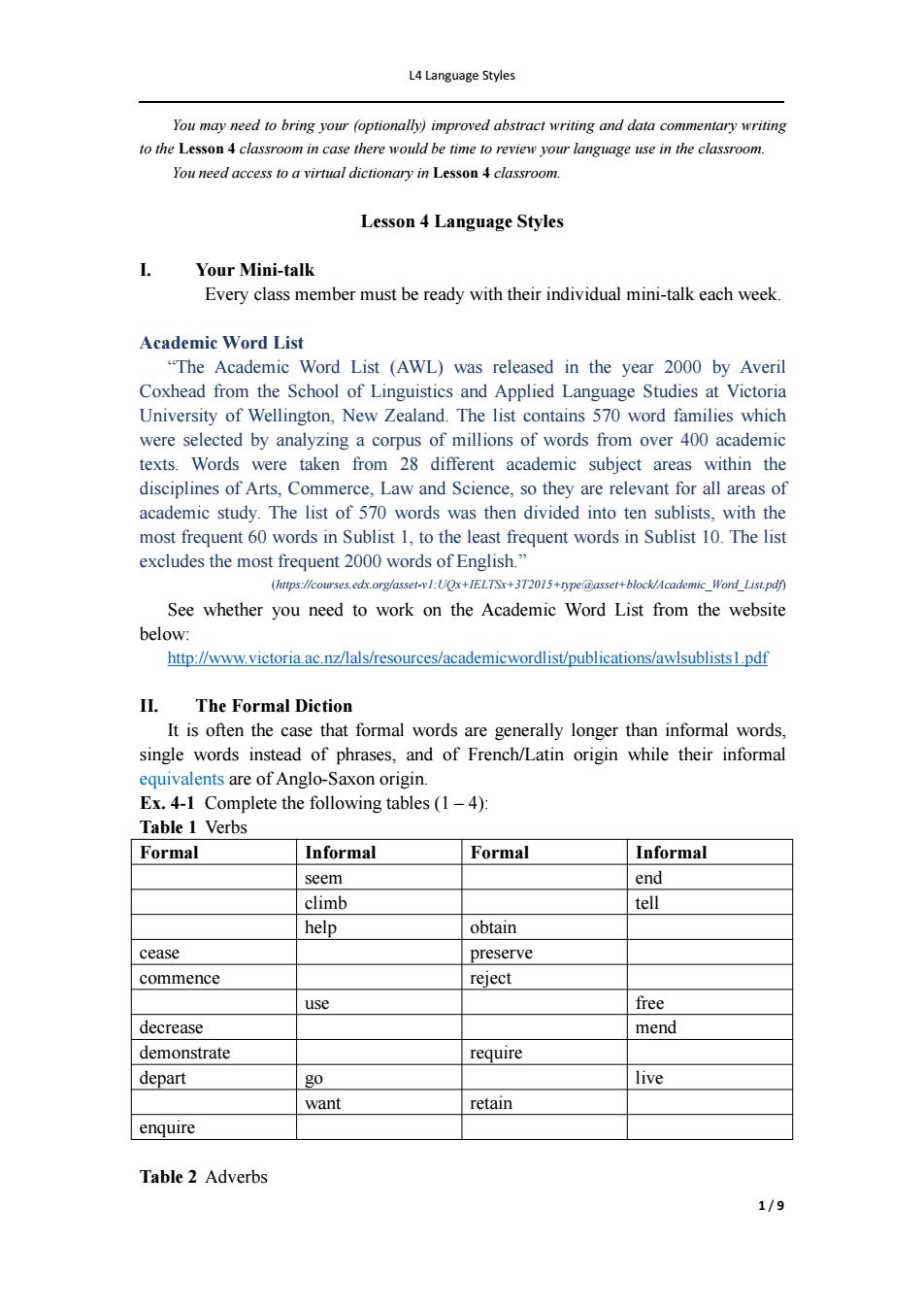
L4 Language Styles You may need to bring your (optionally)improved abstract writing and data commentary writing to the Lesson 4 classroom in case there would be time to review your language use in the classroom. You need access to a virtual dictionary in Lesson 4 classroom. Lesson 4 Language Styles Your Mini-talk Every class member must be ready with their individual mini-talk each week. Academic Word List "The Academic Word List (AWL)was released in the year 2000 by Averil Coxhead from the School of Linguistics and Applied Language Studies at Victoria University of Wellington,New Zealand.The list contains 570 word families which were selected by analyzing a corpus of millions of words from over 400 academic texts.Words were taken from 28 different academic subject areas within the disciplines of Arts,Commerce,Law and Science,so they are relevant for all areas of academic study.The list of 570 words was then divided into ten sublists,with the most frequent 60 words in Sublist 1,to the least frequent words in Sublist 10.The list excludes the most frequent 2000 words of English." (https://courses.edx.org/asset-v1:UQx+IELTSx+3T2015+type@asset+block/Academic_Word List.pdf) See whether you need to work on the Academic Word List from the website below: http://www.victoria.ac.nz/lals/resources/academicwordlist/publications/awlsublists1.pdf II.The Formal Diction It is often the case that formal words are generally longer than informal words, single words instead of phrases,and of French/Latin origin while their informal equivalents are of Anglo-Saxon origin. Ex.4-1 Complete the following tables(1-4): Table 1 Verbs Formal Informal Formal Informal seem end climb tell help obtain cease preserve commence reject use free decrease mend demonstrate require depart go live want retain enquire Table 2 Adverbs 1/9
L4 Language Styles 1 / 9 You may need to bring your (optionally) improved abstract writing and data commentary writing to the Lesson 4 classroom in case there would be time to review your language use in the classroom. You need access to a virtual dictionary in Lesson 4 classroom. Lesson 4 Language Styles I. Your Mini-talk Every class member must be ready with their individual mini-talk each week. Academic Word List “The Academic Word List (AWL) was released in the year 2000 by Averil Coxhead from the School of Linguistics and Applied Language Studies at Victoria University of Wellington, New Zealand. The list contains 570 word families which were selected by analyzing a corpus of millions of words from over 400 academic texts. Words were taken from 28 different academic subject areas within the disciplines of Arts, Commerce, Law and Science, so they are relevant for all areas of academic study. The list of 570 words was then divided into ten sublists, with the most frequent 60 words in Sublist 1, to the least frequent words in Sublist 10. The list excludes the most frequent 2000 words of English.” (https://courses.edx.org/asset-v1:UQx+IELTSx+3T2015+type@asset+block/Academic_Word_List.pdf) See whether you need to work on the Academic Word List from the website below: http://www.victoria.ac.nz/lals/resources/academicwordlist/publications/awlsublists1.pdf II. The Formal Diction It is often the case that formal words are generally longer than informal words, single words instead of phrases, and of French/Latin origin while their informal equivalents are of Anglo-Saxon origin. Ex. 4-1 Complete the following tables (1 – 4): Table 1 Verbs Formal Informal Formal Informal seem end climb tell help obtain cease preserve commence reject use free decrease mend demonstrate require depart go live want retain enquire Table 2 Adverbs
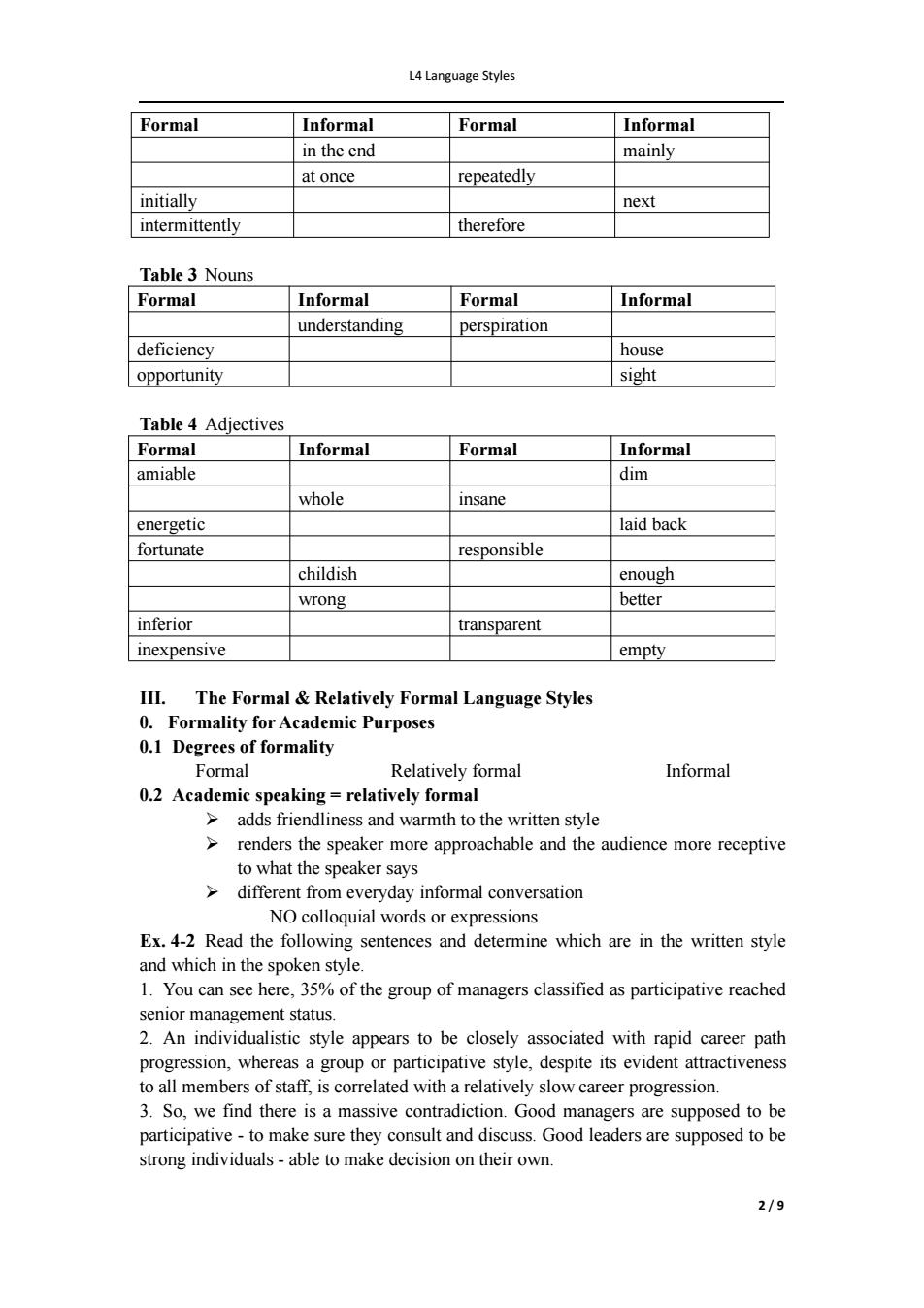
L4 Language Styles Formal Informal Formal Informal in the end mainly at once repeatedly initially next intermittently therefore Table 3 Nouns Formal Informal Formal Informal understanding perspiration deficiency house opportunity sight Table 4 Adjectives Formal Informal Formal Informal amiable dim whole insane energetic laid back fortunate responsible childish enough wrong better inferior transparent inexpensive empty III.The Formal Relatively Formal Language Styles 0.Formality for Academic Purposes 0.1 Degrees of formality Formal Relatively formal Informal 0.2 Academic speaking relatively formal adds friendliness and warmth to the written style renders the speaker more approachable and the audience more receptive to what the speaker says different from everyday informal conversation NO colloquial words or expressions Ex.4-2 Read the following sentences and determine which are in the written style and which in the spoken style. 1.You can see here,35%of the group of managers classified as participative reached senior management status. 2.An individualistic style appears to be closely associated with rapid career path progression,whereas a group or participative style,despite its evident attractiveness to all members of staff,is correlated with a relatively slow career progression. 3.So,we find there is a massive contradiction.Good managers are supposed to be participative-to make sure they consult and discuss.Good leaders are supposed to be strong individuals-able to make decision on their own. 2/9
L4 Language Styles 2 / 9 Formal Informal Formal Informal in the end mainly at once repeatedly initially next intermittently therefore Table 3 Nouns Formal Informal Formal Informal understanding perspiration deficiency house opportunity sight Table 4 Adjectives Formal Informal Formal Informal amiable dim whole insane energetic laid back fortunate responsible childish enough wrong better inferior transparent inexpensive empty III. The Formal & Relatively Formal Language Styles 0. Formality for Academic Purposes 0.1 Degrees of formality Formal Relatively formal Informal 0.2 Academic speaking = relatively formal adds friendliness and warmth to the written style renders the speaker more approachable and the audience more receptive to what the speaker says different from everyday informal conversation NO colloquial words or expressions Ex. 4-2 Read the following sentences and determine which are in the written style and which in the spoken style. 1. You can see here, 35% of the group of managers classified as participative reached senior management status. 2. An individualistic style appears to be closely associated with rapid career path progression, whereas a group or participative style, despite its evident attractiveness to all members of staff, is correlated with a relatively slow career progression. 3. So, we find there is a massive contradiction. Good managers are supposed to be participative - to make sure they consult and discuss. Good leaders are supposed to be strong individuals - able to make decision on their own
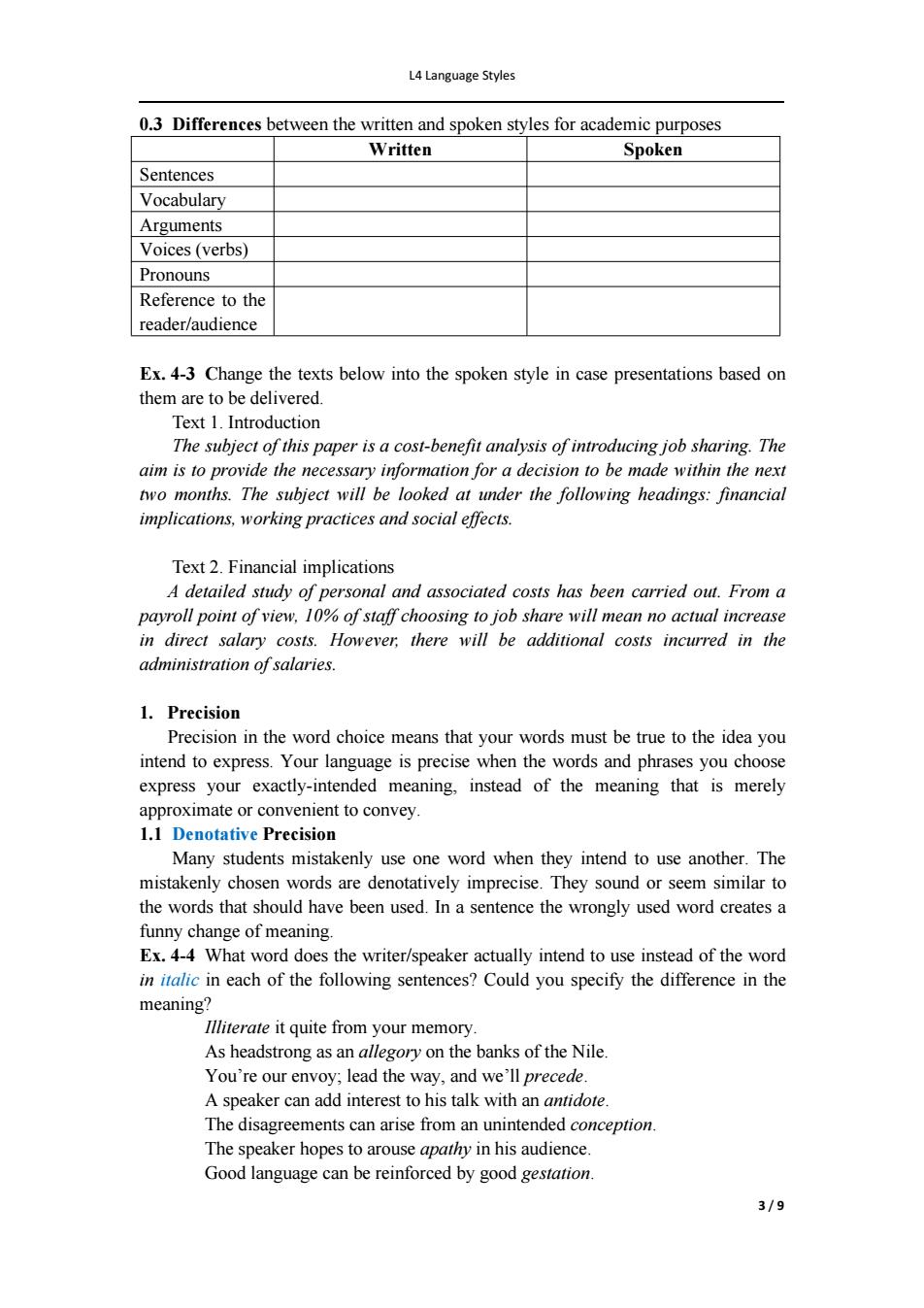
L4 Language Styles 0.3 Differences between the written and spoken styles for academic purposes Written Spoken Sentences Vocabulary Arguments Voices(verbs) Pronouns Reference to the reader/audience Ex.4-3 Change the texts below into the spoken style in case presentations based on them are to be delivered Text 1.Introduction The subject of this paper is a cost-benefit analysis of introducing job sharing.The aim is to provide the necessary information for a decision to be made within the next two months.The subject will be looked at under the following headings:financial implications,working practices and social effects. Text 2.Financial implications A detailed study of personal and associated costs has been carried out.From a payroll point of view,10%of staff choosing to job share will mean no actual increase in direct salary costs.However,there will be additional costs incurred in the administration of salaries. 1.Precision Precision in the word choice means that your words must be true to the idea you intend to express.Your language is precise when the words and phrases you choose express your exactly-intended meaning,instead of the meaning that is merely approximate or convenient to convey. 1.1 Denotative Precision Many students mistakenly use one word when they intend to use another.The mistakenly chosen words are denotatively imprecise.They sound or seem similar to the words that should have been used.In a sentence the wrongly used word creates a funny change of meaning. Ex.4-4 What word does the writer/speaker actually intend to use instead of the word in italic in each of the following sentences?Could you specify the difference in the meaning? Illiterate it quite from your memory. As headstrong as an allegory on the banks of the Nile You're our envoy;lead the way,and we'll precede. A speaker can add interest to his talk with an antidote. The disagreements can arise from an unintended conception. The speaker hopes to arouse apathy in his audience. Good language can be reinforced by good gestation. 3/9
L4 Language Styles 3 / 9 0.3 Differences between the written and spoken styles for academic purposes Written Spoken Sentences Vocabulary Arguments Voices (verbs) Pronouns Reference to the reader/audience Ex. 4-3 Change the texts below into the spoken style in case presentations based on them are to be delivered. Text 1. Introduction The subject of this paper is a cost-benefit analysis of introducing job sharing. The aim is to provide the necessary information for a decision to be made within the next two months. The subject will be looked at under the following headings: financial implications, working practices and social ef ects. Text 2. Financial implications A detailed study of personal and associated costs has been carried out. From a payroll point of view, 10% of staf choosing to job share will mean no actual increase in direct salary costs. However, there will be additional costs incurred in the administration of salaries. 1. Precision Precision in the word choice means that your words must be true to the idea you intend to express. Your language is precise when the words and phrases you choose express your exactly-intended meaning, instead of the meaning that is merely approximate or convenient to convey. 1.1 Denotative Precision Many students mistakenly use one word when they intend to use another. The mistakenly chosen words are denotatively imprecise. They sound or seem similar to the words that should have been used. In a sentence the wrongly used word creates a funny change of meaning. Ex. 4-4 What word does the writer/speaker actually intend to use instead of the word in italic in each of the following sentences? Could you specify the difference in the meaning? Illiterate it quite from your memory. As headstrong as an allegory on the banks of the Nile. You’re our envoy; lead the way, and we’ll precede. A speaker can add interest to his talk with an antidote. The disagreements can arise from an unintended conception. The speaker hopes to arouse apathy in his audience. Good language can be reinforced by good gestation
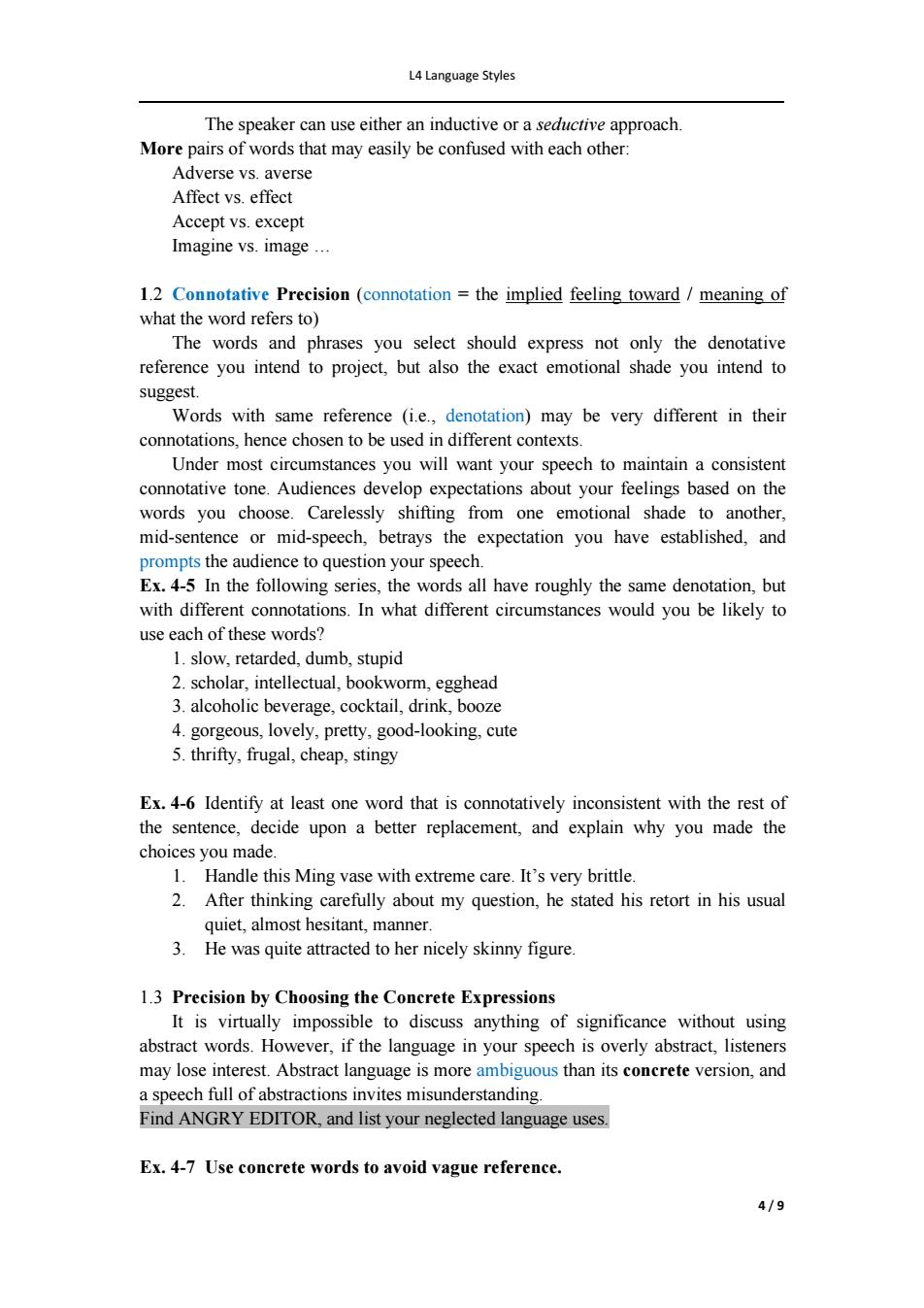
L4 Language Styles The speaker can use either an inductive or a seductive approach. More pairs of words that may easily be confused with each other: Adverse vs.averse Affect vs.effect Accept vs.except Imagine vs.image... 1.2 Connotative Precision (connotation the implied feeling toward meaning of what the word refers to) The words and phrases you select should express not only the denotative reference you intend to project,but also the exact emotional shade you intend to suggest. Words with same reference (i.e.,denotation)may be very different in their connotations,hence chosen to be used in different contexts. Under most circumstances you will want your speech to maintain a consistent connotative tone.Audiences develop expectations about your feelings based on the words you choose.Carelessly shifting from one emotional shade to another, mid-sentence or mid-speech,betrays the expectation you have established,and prompts the audience to question your speech. Ex.4-5 In the following series,the words all have roughly the same denotation,but with different connotations.In what different circumstances would you be likely to use each of these words? 1.slow,retarded,dumb,stupid 2.scholar,intellectual,bookworm,egghead 3.alcoholic beverage,cocktail,drink,booze 4.gorgeous,lovely,pretty,good-looking,cute 5.thrifty,frugal,cheap,stingy Ex.4-6 Identify at least one word that is connotatively inconsistent with the rest of the sentence,decide upon a better replacement,and explain why you made the choices you made. 1.Handle this Ming vase with extreme care.It's very brittle. 2.After thinking carefully about my question,he stated his retort in his usual quiet,almost hesitant,manner. 3.He was quite attracted to her nicely skinny figure. 1.3 Precision by Choosing the Concrete Expressions It is virtually impossible to discuss anything of significance without using abstract words.However,if the language in your speech is overly abstract,listeners may lose interest.Abstract language is more ambiguous than its concrete version,and a speech full of abstractions invites misunderstanding Find ANGRY EDITOR,and list your neglected language uses. Ex.4-7 Use concrete words to avoid vague reference. 4/9
L4 Language Styles 4 / 9 The speaker can use either an inductive or a seductive approach. More pairs of words that may easily be confused with each other: Adverse vs. averse Affect vs. effect Accept vs. except Imagine vs. image … 1.2 Connotative Precision (connotation = the implied feeling toward / meaning of what the word refers to) The words and phrases you select should express not only the denotative reference you intend to project, but also the exact emotional shade you intend to suggest. Words with same reference (i.e., denotation) may be very different in their connotations, hence chosen to be used in different contexts. Under most circumstances you will want your speech to maintain a consistent connotative tone. Audiences develop expectations about your feelings based on the words you choose. Carelessly shifting from one emotional shade to another, mid-sentence or mid-speech, betrays the expectation you have established, and prompts the audience to question your speech. Ex. 4-5 In the following series, the words all have roughly the same denotation, but with different connotations. In what different circumstances would you be likely to use each of these words? 1. slow, retarded, dumb, stupid 2. scholar, intellectual, bookworm, egghead 3. alcoholic beverage, cocktail, drink, booze 4. gorgeous, lovely, pretty, good-looking, cute 5. thrifty, frugal, cheap, stingy Ex. 4-6 Identify at least one word that is connotatively inconsistent with the rest of the sentence, decide upon a better replacement, and explain why you made the choices you made. 1. Handle this Ming vase with extreme care. It’s very brittle. 2. After thinking carefully about my question, he stated his retort in his usual quiet, almost hesitant, manner. 3. He was quite attracted to her nicely skinny figure. 1.3 Precision by Choosing the Concrete Expressions It is virtually impossible to discuss anything of significance without using abstract words. However, if the language in your speech is overly abstract, listeners may lose interest. Abstract language is more ambiguous than its concrete version, and a speech full of abstractions invites misunderstanding. Find ANGRY EDITOR, and list your neglected language uses. Ex. 4-7 Use concrete words to avoid vague reference
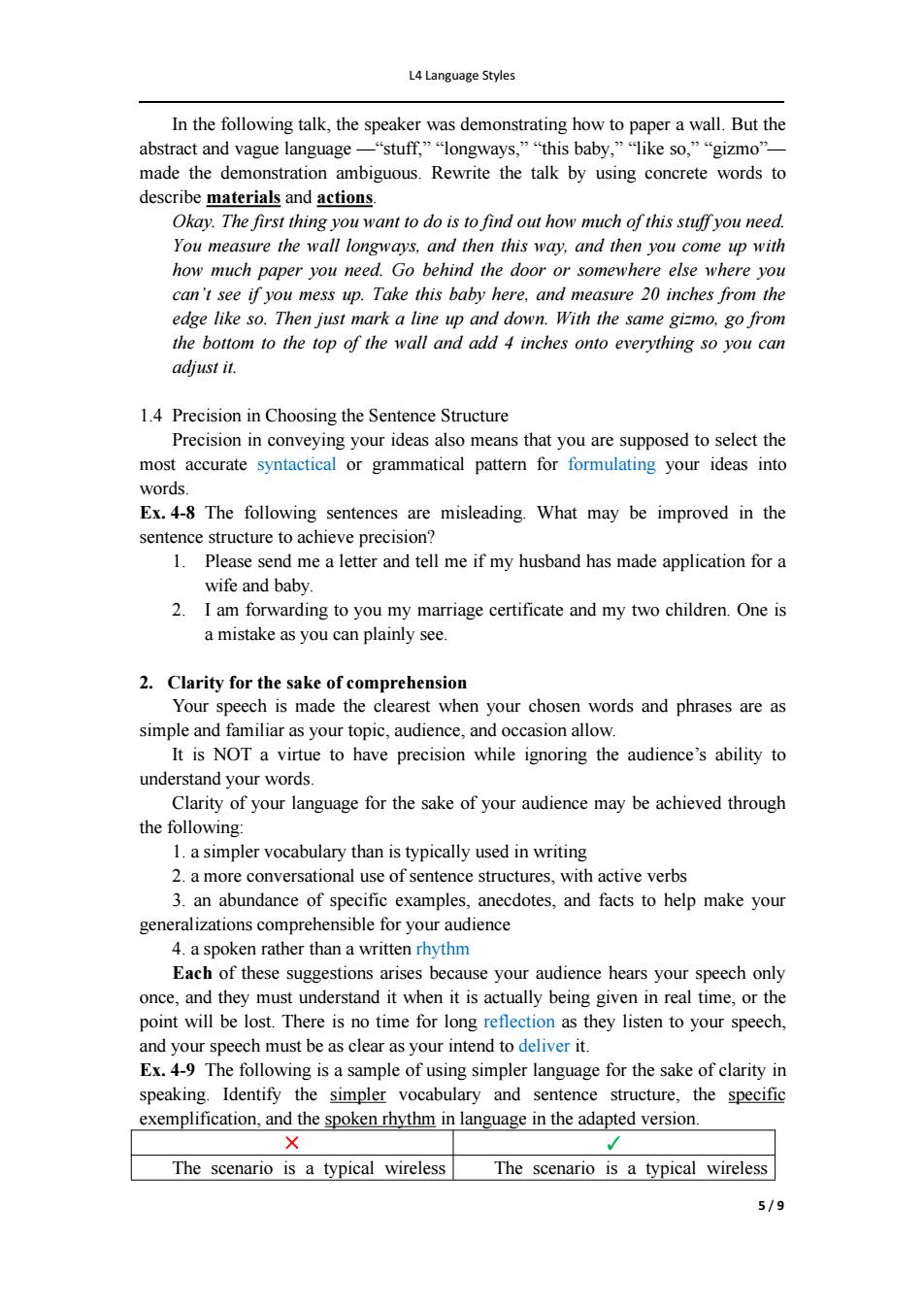
L4 Language Styles In the following talk,the speaker was demonstrating how to paper a wall.But the abstract and vague language-“stuff,.”“longways,”“this baby,"like so,”“gizmo'”- made the demonstration ambiguous.Rewrite the talk by using concrete words to describe materials and actions. Okay.The first thing you want to do is to find out how much of this stuffyou need. You measure the wall longways,and then this way,and then you come up with how much paper you need.Go behind the door or somewhere else where you can't see if you mess up.Take this baby here,and measure 20 inches from the edge like so.Then just mark a line up and down.With the same gizmo,go from the bottom to the top of the wall and add 4 inches onto everything so you can adjust it. 1.4 Precision in Choosing the Sentence Structure Precision in conveying your ideas also means that you are supposed to select the most accurate syntactical or grammatical pattern for formulating your ideas into words. Ex.4-8 The following sentences are misleading.What may be improved in the sentence structure to achieve precision? 1.Please send me a letter and tell me if my husband has made application for a wife and baby. 2.I am forwarding to you my marriage certificate and my two children.One is a mistake as you can plainly see. 2.Clarity for the sake of comprehension Your speech is made the clearest when your chosen words and phrases are as simple and familiar as your topic,audience,and occasion allow. It is NOT a virtue to have precision while ignoring the audience's ability to understand your words. Clarity of your language for the sake of your audience may be achieved through the following: 1.a simpler vocabulary than is typically used in writing 2.a more conversational use of sentence structures,with active verbs 3.an abundance of specific examples,anecdotes,and facts to help make your generalizations comprehensible for your audience 4.a spoken rather than a written rhythm Each of these suggestions arises because your audience hears your speech only once,and they must understand it when it is actually being given in real time,or the point will be lost.There is no time for long reflection as they listen to your speech, and your speech must be as clear as your intend to deliver it. Ex.4-9 The following is a sample of using simpler language for the sake of clarity in speaking.Identify the simpler vocabulary and sentence structure,the specific exemplification,and the spoken rhythm in language in the adapted version. X The scenario is a typical wireless The scenario is a typical wireless 5/9
L4 Language Styles 5 / 9 In the following talk, the speaker was demonstrating how to paper a wall. But the abstract and vague language —“stuff,” “longways,” “this baby,” “like so,” “gizmo”— made the demonstration ambiguous. Rewrite the talk by using concrete words to describe materials and actions. Okay. The first thing you want to do is to find out how much of this stuf you need. You measure the wall longways, and then this way, and then you come up with how much paper you need. Go behind the door or somewhere else where you can’t see if you mess up. Take this baby here, and measure 20 inches from the edge like so. Then just mark a line up and down. With the same gizmo, go from the bottom to the top of the wall and add 4 inches onto everything so you can adjust it. 1.4 Precision in Choosing the Sentence Structure Precision in conveying your ideas also means that you are supposed to select the most accurate syntactical or grammatical pattern for formulating your ideas into words. Ex. 4-8 The following sentences are misleading. What may be improved in the sentence structure to achieve precision? 1. Please send me a letter and tell me if my husband has made application for a wife and baby. 2. I am forwarding to you my marriage certificate and my two children. One is a mistake as you can plainly see. 2. Clarity for the sake of comprehension Your speech is made the clearest when your chosen words and phrases are as simple and familiar as your topic, audience, and occasion allow. It is NOT a virtue to have precision while ignoring the audience’s ability to understand your words. Clarity of your language for the sake of your audience may be achieved through the following: 1. a simpler vocabulary than is typically used in writing 2. a more conversational use of sentence structures, with active verbs 3. an abundance of specific examples, anecdotes, and facts to help make your generalizations comprehensible for your audience 4. a spoken rather than a written rhythm Each of these suggestions arises because your audience hears your speech only once, and they must understand it when it is actually being given in real time, or the point will be lost. There is no time for long reflection as they listen to your speech, and your speech must be as clear as your intend to deliver it. Ex. 4-9 The following is a sample of using simpler language for the sake of clarity in speaking. Identify the simpler vocabulary and sentence structure, the specific exemplification, and the spoken rhythm in language in the adapted version. × ✓ The scenario is a typical wireless The scenario is a typical wireless